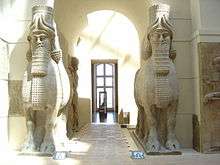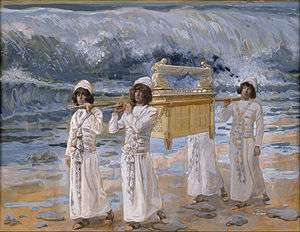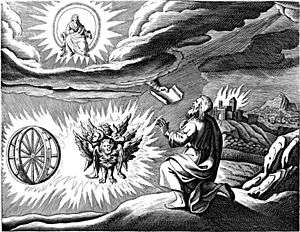Cherub

A cherub (/ˈtʃɛrəb/;[1] also pl. cherubim; Hebrew: כְּרוּב kərūv, pl. כְּרוּבִים, kərūvîm; Latin cherub, pl. cherubin, cherubim; Syriac ܟܪܘܒܐ) is one of the unearthly beings who directly attend to God according to Abrahamic religions. The numerous depictions of cherubim assign to them many different roles; their original duty having been the protection of the Garden of Eden.[2] Angelic status is not attributed to cherubim in the Old Testament (at least not explicitly);[3] only in later sources like De Coelesti Hierarchia are they identified as a hierarchical rank of angels.[4]
Different sources give conflicting information as to the physical appearance of cherubim.[5] An early, traditional Jewish notion supposes that cherubim had youthful, human features (although some early midrashic literature conceives of the cherubim as non-corporeal).[3] In the Book of Ezekiel and (at least some) Christian icons, the cherub is depicted as having a number of wing pairs, and four faces: that of a lion (representative of all wild animals), an ox (domestic animals), a human (humanity), and an eagle (birds).[5] In Christian tradition, cherubim have become associated with the putto and the Greco-Roman deity Cupid/Eros, resulting in the misconception that cherubim are small and plump winged boys.[3]
Origins and etymology

The origin of the symbolic cherub antedates history, and points to the time when man began to shape his ideas of supernatural powers by mystic forms, especially the combination of parts of the strongest animals of land and air (the lion and the eagle), which resulted in the numerous grotesque figures in Middle Eastern lore and architecture. One of these is the Babylonian lamassu, a protective spirit with a sphinx-like form, possessing the wings of an eagle, the body of a lion, and the head of a king. This was adopted largely in Phoenicia. The wings, because of their artistic beauty, soon became the most prominent part, and animals of various kinds were adorned with wings; consequently, wings were bestowed also upon man,[2] thus forming the stereotypical image of an angel.[6] Another probable source is the human-bodied Hittite griffin, which, unlike other griffins, appear almost always not as a fierce bird of prey, but seated in calm dignity, like an irresistible guardian of holy things;[2][6] some have proposed that the Hittite word for "griffin" may be cognate with cherubim.[7]
The traditional Hebrew conception of cherubim as guardians of the Garden of Eden is backed by the Semitic belief of beings of superhuman power and devoid of human feelings, whose duty it was to represent the gods, and as guardians of their sanctuaries to repel intruders; these conceptions in turn are similar to an account found on Tablet 9 of the inscriptions found at Nimrud.[2] It has been suggested that the image of cherubim as storm winds explains why they are described as being the chariot of Yahweh in Ezekiel's visions, the Books of Samuel,[8] the parallel passages in the later Books of Chronicles,[9] and passages in the early Psalms:[2] for example "and he rode upon a cherub and did fly: and he was seen upon the wings of the wind."[10][11]
Dhorme argued in 1926 that cognates of the Hebrew noun could be found in the Akkadian words kāribu and the diminutive kurību; these terms are used to refer to intercessory beings (and statues of such beings) that plead with the gods on behalf of humanity.[12] He thus concludes that cherubim had an intercessory role. This conclusion, based on extra-biblical sources, is still drawn upon in relatively recent commentaries and articles.[12] Friedrich Delitzch connected the Hebrew word cherubim with the Assyrian terms kirubu (shedu- a being who is very similar to the lamassu in both appearance and role, but has the body of a bull) and karabu ('great, mighty'). Karppe states that the name Cherubim is Babylonian, and that it does not mean 'powerful', but, however, 'propitious'.[2][13] However, while the shedu were popular in Mesopotamia, archaeological remains from the Levant suggest that they were quite rare in the immediate vicinity of the Israelites.[14] In particular, in a scene reminiscent of Ezekiel's dream, the Megiddo Ivories depict an unknown king being carried on his throne by hybrid winged-creatures.[6]
In Judaism
In the Hebrew Bible

The cherubim are the most frequently occurring heavenly creature in the Hebrew Bible, with the Hebrew word appearing 91 times.[5] Despite these many references, the role of the cherubim is never explicitly elucidated.[3] While Hebrew tradition must have conceived of the cherubim as guardians of the Garden of Eden[2] (in which they guard the way to the Tree of life),[15] they are often depicted as performing other roles, for example in the Book of Ezekiel, they transport Yahweh's throne. The cherub who appears in the "Song of David", a poem which occurs twice in the Hebrew Bible, in 2 Samuel 22 and Psalm 18, participates in Yahweh's theophany and is imagined as a vehicle upon which the deity descends to earth from heaven in order to rescue the speaker (see 2 Samuel 22:11, Psalm 18:10).[16]
Other than in the book of Ezekiel, the Bible describes cherubim with one face, one pair of wings, and four feet.[5]
In Exodus 25:18-22, Yahweh tells Moses to make multiple images of cherubim at specific points around the Ark of the Covenant.[5] Many appearances of the words cherub and cherubim in the Bible refer to the gold cherubim images on the mercy seat of the Ark, as well as images on the curtains of the Tabernacle and in Solomon's Temple, including two measuring ten cubits high.[17]
In Isaiah 37:16, Hezekiah prays, addressing Yahweh as "enthroned above the cherubim" (referring to the mercy seat).
Cherubim feature at some length in the Book of Ezekiel. While they first appear in chapter one, in which they are transporting the throne of Yahweh by the river Chebar, they are not called cherubim until chapter 10.[18] In Ezekiel 1:5-11 they are described as having the likeness of a man, and having four faces: that of a man, a lion (on the right side), and ox (on the left side), and an eagle. The four faces represent the four domains of God's rule: the man represents humanity; the lion, wild animals; the ox, domestic animals; and the eagle, birds.[19] These faces peer out from the center of an array of four wings; these wings are joined to each other, two of these are stretched upward, and the other two cover their bodies. Under their wings are human hands; their legs are described as straight, and their feet like those of a calf, and shone like polished brass. Between the creatures glowing coals that moved between them could be seen, their fire "went up and down", and lightning burst forth from it. The cherubs also moved like flashes of lightning.
In Ezekiel chapter ten, another full description of the cherubim appears with slight differences in details. Three of the four faces are the same – man, lion and eagle – but where chapter one has the face of an ox, Ezekiel 10:14 says "face of a cherub." Ezekiel equates the cherubim of chapter ten with the living creatures of chapter one: "They were the same creatures (חיה) I had seen by the river Chebar" (Ezekiel 10:15) and "These were the living creatures I had seen under the God of Israel on the banks of the river Chebar" (Ezekiel 10:20). In Ezekiel 41:18-20, they are portrayed as having two faces, although this is probably because they are depicted in profile.[5]
In the Hebrew Bible the cherubim do not have the status of angels. It is only in later sources like the De Coelesti Hierarchia (see below) that they are considered to be a division of the divine messengers.[4]
In extrabiblical sources
The figures painted on the walls of the Herodian reconstruction of the Temple are called "cherubim" in the Babylonian Talmud.[20]

Many forms of Judaism include a belief in the existence of angels, including cherubim within the Jewish angelic hierarchy. The existence of angels is generally accepted within traditional rabbinic Judaism. There is, however, a wide range of beliefs within Judaism about what angels actually are and how literally one should interpret biblical passages associated with them.
In Kabbalah there has long been a strong belief in cherubim, with the cherubim and other angels regarded as having mystical roles. The Zohar, a highly significant collection of books in Jewish mysticism, states that the cherubim were led by one of their number named Kerubiel.[2]
On the other end of the philosophical spectrum is Maimonides, who had a neo-Aristotelian interpretation of the Bible. Maimonides writes that to the wise man, one sees that what the Bible and Talmud refer to as "angels" are actually allusions to the various laws of nature; they are the principles by which the physical universe operates.
For all forces are angels! How blind, how perniciously blind are the naive?! If you told someone who purports to be a sage of Israel that the Deity sends an angel who enters a woman's womb and there forms an embryo, he would think this a miracle and accept it as a mark of the majesty and power of the Deity, despite the fact that he believes an angel to be a body of fire one third the size of the entire world. All this, he thinks, is possible for God. But if you tell him that God placed in the sperm the power of forming and demarcating these organs, and that this is the angel, or that all forms are produced by the Active Intellect; that here is the angel, the "vice-regent of the world" constantly mentioned by the sages, then he will recoil.– The Guide for the Perplexed II:4
For he [the naive person] does not understand that the true majesty and power are in the bringing into being of forces which are active in a thing although they cannot be perceived by the senses....Thus the Sages reveal to the aware that the imaginative faculty is also called an angel; and the mind is called a cherub. How beautiful this will appear to the sophisticated mind, and how disturbing to the primitive." – The Guide for the Perplexed II:6.
Maimonides says that the figures of the cherubim were placed in the sanctuary only to preserve among the people the belief in angels, there being two in order that the people might not be led to believe that they were the image of God.[21]
Cherubim are discussed within the midrash literature. The two cherubim placed by God at the entrance of paradise (Gen. iii. 24) were angels created on the third day, and therefore they had no definite shape; appearing either as men or women, or as spirits or angelic beings (Genesis Rabbah xxi., end). The cherubim were the first objects created in the universe (Tanna debe Eliyahu R., i. beginning). The following sentence of the Midrash is characteristic: "When a man sleeps, the body tells to the neshamah (soul) what it has done during the day; the neshamah then reports it to the nefesh (spirit), the nefesh to the angel, the angel to the cherub, and the cherub to the seraph, who then brings it before God" (Leviticus Rabbah xxii.; Eccl. Rabbah x. 20).
In early Jewish tradition there existed the notion that cherubim had youthful, human features.[3] Despite this tradition, some early midrashic literature conceives of the cherubim as non-corporeal.[3] In the first century AD, Josephus claimed:"No one can tell, or even conjecture, what was the shape of these Cherubim."(Antiquities:8:73).[3]
A midrash states that when Pharaoh pursued Israel at the Red Sea, God took a cherub from the wheels of His throne and flew to the spot, for God inspects the heavenly worlds while sitting on a cherub. The cherub, however, is "something not material," and is carried by God, not vice versa (Midr. Teh. xviii. 15; Canticles Rabbah i. 9).
In the passages of the Talmud that describe the heavens and their inhabitants, the seraphim, ofannim, and living creatures are mentioned, but not the cherubim (Ḥag. 12b); and the ancient liturgy also mentions only these three classes.
In the Talmud, Jose the Galilean holds[22] that when the Birkat Hamazon (grace after meals) is recited by at least ten thousand seated at one meal, a special blessing, "Blessed is Ha-Shem our God, the God of Israel, who dwells between the Cherubim," is added to the regular liturgy.
In Christianity
In Medieval theology, following the writings of Pseudo-Dionysius, the cherubim are the second highest rank in the angelic hierarchy, following the seraphim.[23]
Cherubim are regarded in traditional Christian angelology as angels of the second highest order of the ninefold celestial hierarchy.[24]
Cherubim have become erroneously associated with the putto and the Greco-Roman god Cupid/Eros, resulting in the misconception that cherubim are small and plump winged boys.[3]
In Islam
Cherubs are not mentioned by name in either the Quran or authentic Hadith, but many traditions based on these sources have developed about them. In Islamic tradition, cherubs are angels who hold God's throne. They ask God to forgive, bless and protect the righteous. In 40:8, the Quran says:
Those [angels] who carry the Throne and those around it exalt [Allah] with praise of their Lord and believe in Him and ask forgiveness for those who have believed, [saying], "Our Lord, You have encompassed all things in mercy and knowledge, so forgive those who have repented and followed Your way and protect them from the punishment of Hellfire.
Also in 69:17-18:
And the heaven will split [open], for that Day [Judgement Day] it is infirm. And the angels are at its edges. And there will bear the Throne of your Lord above them, that Day, eight [of them].
Having noticed the resemblance between those angels and the Judeo-Christian depiction of cherubs, some Muslim scholars came to the conclusion that the angelic rank responsible for holding God's throne and praising him according to the previous verses is the cherubim.[25] Some Hadith, considered inauthentic owing to their weak chains of narration, mention cherubs by name.[26]
Fakhr Al-Din Al-Turaihi, a Muslim scholar who lived in the 17th Century C.E, believed that the archangel Gabriel is the head of the cherubim.[27] A Hadith in Shiite tradition tells us that Muhammad heard cherubs wailing and crying with sympathy for sinners in Heaven during his night journey, known as Isra and Mi'raj. Other traditions say that cherubs are so bright that the light of one of them could suffice the whole world. When Moses asked God to show him his face, he made one of his cherubs shine upon the mountain, shattering it to pieces. According to this tradition, God was showing Moses that since he could not bear to look at a cherub, he would not be able to bear looking at God.[28]
See also
- Buraq
- Cherubism (medical condition)
- Cupid and Kamadeva
- Merkabah mysticism
- Tetramorph
- Seraph
References
- ↑ "cherub". Random House Webster's Unabridged Dictionary.
- 1 2 3 4 5 6 7 8 "Jewish Encyclopedia: cherub". Original, 1906. JewishEncyclopedia.com, 2002-2011.
- 1 2 3 4 5 6 7 8 Wood, Alice. Of Wings and Wheels: A Synthetic Study of the Biblical Cherubim. p. 1.
- 1 2 Kosior, Wojciech. "The Angel in the Hebrew Bible from the Statistic and Hermeneutic Perspectives. Some Remarks on the Interpolation Theory". The Polish Journal of Biblical Research, Vol. 12, No. 1 (23), pp. 56-57. Retrieved 1 December 2013.
- 1 2 3 4 5 6 Wood, Alice. Of Wing and Wheels: A Synthetic Study of the Biblical Cherubim. p. 2. ISBN 978-3-11-020528-2.Wood, Alice. Of Wing and Wheels: A Synthetic Study of the Biblical Cherubim. pp. 3–4. ISBN 978-3-11-020528-2.
- 1 2 3 Wright, G. Ernest, Biblical Archaeology (Philadelphia, Westminster Press, 1957)
- ↑ William H. Propp, Exodus 19-40, volume 2A of The Anchor Bible, New York: Doubleday, 2006, ISBN 0-385-24693-5, Notes to Exodus 15:18, page 386, referencing:Julius Wellhausen, Prolegomena to the History of Israel, Edinburgh: Black, 1885, page 304. Also see: Robert S. P. Beekes,Etymological Dictionary of Greek, volume 1, Leiden and Boston: Brill, 2010 ISBN 978-90-04-17420-7, page 289, entry for γρυπος,"From the archaeological perspective, origin in Asia Minor (and the Near East: Elam) is very probable."
- ↑ 1 Samuel 4:4, 2 Samuel 6:2, 2 Samuel 22:11
- ↑ 1 Chronicles 13:6
- ↑ 2 Samuel 22:11
- ↑ Psalms 18:10
- 1 2 Wood, Alice. Of Wings and Wheels:A Synthetic Study of the Biblical Cherubim. pp. 3–4.
- ↑ De Vaux, Roland (tr. John McHugh), Ancient Israel: Its Life and Institutions (NY, McGraw-Hill, 1961)
- ↑ Peake's commentary on the Bible
- ↑ Genesis 3:24 (King James Version) at Bible Gateway.com
- ↑ Wood, Alice. Of Wings and Wheels: A Synthetic Study of the Biblical Cherubim. pp. 84–85.
- ↑ "1 kings 6:23-6:35 KJV - And within the oracle he made two". Bible Gateway. Retrieved 2012-12-30.
- ↑ Wood, Alice. Of Wings and Wheels: A Synthetic Study of the Biblical Cherubim. p. 94.
- ↑ Wood, Alice. Of Wings and Wheels: A Synthetic Study of the Biblical Cherubim. p. 137.
- ↑ Yoma 54a: "it had painted Cherubim, as it is written."
- ↑ The Guide for the Perplexed III:45
- ↑ Berakhot 49b
- ↑ Dionysius the Areopagite's Celestial Hierarchy - See Chapter VII
- ↑ "Oxford Dictionaries: cherub". Oxford University Press. 2013.
- ↑ Tafsir al-Qur'an al-adhim (Interpretation of the Great Qur'an) - Ibn Kathir
- ↑ 49b (Adapted from islamqa.info)
- ↑ Majma Al-Bahrain (Junction of the two seas) - Fakhr Al-Di Al-Turaihi
- ↑ "من هم الكَرّوبيّون ؟". مركز الإشعاع الإسلامي.
Further reading
- Yaniv, Bracha, The Cherubim on Torah Ark Valances, Jewish Art Department, Bar-Ilan University, published in Assaph: Studies in Art History, Vol.4, 1999
External links
| Wikimedia Commons has media related to Cherubs. |
- Jewish Encyclopedia: Cherub
- Catholic Encyclopedia: Cherubim
- The Cherubim - some pointers and problems by Rabbi Dr Raymond Apple
-
 "Cherubim". Encyclopædia Britannica. 6 (11th ed.). 1911. pp. 86–87.
"Cherubim". Encyclopædia Britannica. 6 (11th ed.). 1911. pp. 86–87.
